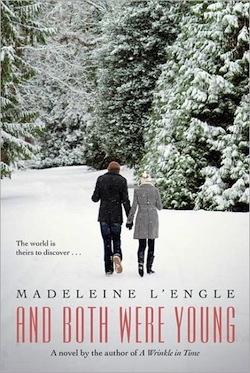After Madeleine L’Engle delivered the manuscript of And Both Were Young to her publishers in the late 1940s, they asked her to remove material “inappropriate” for a teenage audience. She did so, an early step in a career that would soon be focusing on young adult novels, with occasional forays into adult novels. In 1983, she was able to capitalize on her popularity and have the book reprinted with those “inappropriate” elements restored.
Not that anything in the 1983 And Both Were Young feels particularly shocking. L’Engle’s foreword to the restored 1983 edition only notes that death and sex were considered unmentionable subjects for 1940s young adult literature, resulting in a “sanitized” manuscript. I have to say, the references to sex and death in even the 1983 edition are pretty sanitized—the Anne of Green Gables series has raunchier moments—and this book contains nothing objectionable for contemporary readers, suggesting that L’Engle’s publishers were cautious indeed.
Anyway. The book.
And They Were Young is the story of Philippa Hunter, called Flip, a young girl who has recently lost her mother in a car crash, sent away to a boarding school in Europe a few years after World War II as her father travels the world, to heal emotionally and illustrate a couple of books. Flip is miserable, missing her father and terrified that he is going to marry a woman who she despises. Fortunately enough, she meets a boy named Paul, who has no memory of his past, but is good looking and charming and an excellent distraction. (I’m assuming that a scene where they—squeak—meet alone in her bedroom in the dark was one of the removed elements, although neither of them take any real advantage of this moment.)
The less successful part of the book focuses on Paul and his attempts to regain his memories; he has forgotten most of his life, it turns out, because he was in a concentration camp, and wanted and needed to forget. Fortunately, most of the book focuses on Flip learning to accept the school and her friends and become considerably less self-absorbed, and on Flip, initially the isolated loser of the group, winning acceptance from her peers.
The book is loosely based both on L’Engle’s own memories of attending boarding schools in Switzerland and on the girls boarding school stories highly popular at the time. L’Engle, to her credit, does not offer up mere clichés, but Flip’s classmates do include the class clown (here combined with the class rich girl), the snob, the gossipy girl, the serene and competent class president that everyone admires, and so on. Naturally, Flip is forced to practice in quiet and receive secret lessons from a teacher and Paul so that she can stun the school with her competence. And so on.
But some small elements do make the book stand out. For one, Flip’s main issue with the school is not the school itself or homesickness, but that she can seemingly never be alone, and for someone still mourning her mother and needing space, this is a serious problem. (She ends up spending significant time hiding in the school chapel, which in later L’Engle books would be the beginning of a religious theme, but here is genuinely just used as a hiding space.) For two, a small scene later in the book about heroism, and its aftermath, draws on World War II to gain some real power.
L’Engle readers may be surprised by this book. It doesn’t necessarily sound like a L’Engle novel, and it avoids her usual focus on religion and science, found even in her mainstream novels. It also contains a character who is—shockingly for L’Engle—content that her parents are divorced and comfortable with the thought that they are sleeping around. (Some of her later characters would voice near hysteria at the mere suggestion that their parents might be committing adultery.)
But it does feature the intelligent, socially unsure and awkward teenage protagonist that would become a staple of her work. It also features several characters who continue on, despite sorrow and severe trauma, continuing to find joy in life, another staple. And it contains much of the warmth that would appear in most—not all—of her later works. If considerably lighter (even with the concentration camp and escaping from Nazi Germany subplot) than most of her later work, this is still a happy, satisfying read, giving L’Engle the foundations she needed to produce her later novels.
Mari Ness reads a lot. She lives in central Florida.










